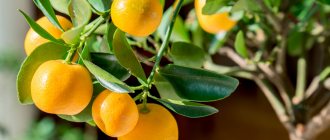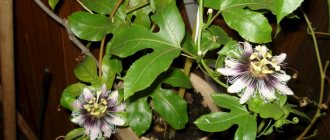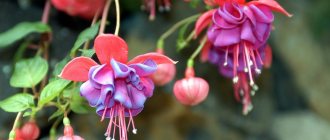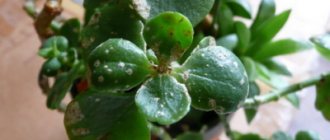Description of calamondin
It has several names: citrofortunella microcarpa, golden orange, calamondin variegated, indoor mandarin. The most common name is citrofortunella. This hybrid is the result of breeders crossing a tangerine and a kumquat. Citrofortunella was brought to us from Southeast Asia.
Indoors, this tree grows up to 1 meter in height, although in natural conditions it can reach 5 meters. The crown is highly branched. The shoots are brown in color. The leaves are small in size. Flowers bloom in spring.
The fruits are small, only 15-20 grams. In appearance they are very similar to tangerines. It can be used instead of lemon, and the peel is also edible.
Description
Citrofortunella is a popular hybrid of the Rutaceae family, obtained by crossing Fortunella (Kincana) with Mandarin.
It is a fast-growing, ornamental tree with a compact crown. The numerous branches bear glossy, leathery, oval-shaped leaves. If you rub the leaf blade, a pleasant aroma is released. Citrofortunella differs from other representatives of the Citrus genus in the absence of thorns on its shoots. The tree is quite decorative. Reaches a height of up to 1.2 m. White, fragrant flowers develop en masse in the summer, and singly at any time of the year. This representative of the flora is especially beautiful during the simultaneous flowering and formation of orange fruits, similar to small oranges. Because of their distinctive, bitter-sour taste, Citrofortunella fruits are of more decorative value than serve as edible Citrus fruits.
The plant is unpretentious in care. Under optimal growing conditions, it bears fruit all year round. Used to decorate the interior of a living room, greenhouse.
Creating conditions for growing calamondin
How to grow calamondin? Of course, it feels better in its natural environment, but it can also be grown at home.
- For citrofortunella, it is better to choose a spacious room so that nothing interferes with the growth of its branches.
- It is advisable that the room's windows face east in summer, and north in winter. You should not place a pot with this plant on the south side of the apartment. Very bright light negatively affects the fruiting of the tree. Sometimes leaves fall. If it is not possible to remove it from the sunny room, then you should install a barrier that provides diffused light, such as a dark curtain.
- In summer, it is recommended to take the tree out into the open air, but do not place it in direct sunlight.
- To ensure that the branches grow evenly, the tree is turned a few centimeters towards the sunlight every day.
- In addition, the tree must be protected from drafts.
- The optimal temperature that should be maintained in the summer during its cultivation is +25 degrees. In winter, it is reduced to +15 degrees.
- Caring for calamondin is not difficult, but an important factor for it is the watering regime. Golden orange is a fairly moisture-loving plant. The amount of water for irrigation is determined taking into account the temperature regime in which the tree is located. The main indicator that watering is required is the moment the soil dries out at a depth of 0.5 centimeters. The largest amount of water is applied in summer and spring, and by autumn watering is slightly reduced. Due to lack of moisture, the foliage turns yellow and then curls up. However, during flowering, calamondin is not watered so as not to harm fruit set.
- Golden orange is suitable for spraying with a spray bottle. The water should be settled and warm.
Note! A young plant needs more moisture than an adult citrofortunella requires.
Citrofortunella on the grid
An ornamental, evergreen plant no more than 2 meters high, with beautiful white flowers and tasty, aromatic fruits.
Citrofortunella blooms and produces fruits all year round. The fruits sometimes hang on the tree for several months. It is better to keep Citrofortunella outdoors in summer, in the warmest and sunniest place, and in winter in a bright place at a temperature of 15-18 degrees. Citrofortunella Lemon is a hybrid perennial evergreen tree from the Rutaceae family. It is distinguished by its compact size, short dormant period and attractive appearance. During flowering, the tree is strewn with white fragrant flowers, in the place of which miniature lemons then appear. The plant can bloom up to 3 times during the year.
Citrofortunella needs to be watered abundantly from the beginning of spring to the beginning of winter. Lime water has a detrimental effect on the plant. In winter, watering should be limited. Fertilizers must be applied in small portions from March to August. Citrofortunella needs frequent spraying; when the earthen ball is completely enveloped by roots, the plant must be transplanted into a larger pot with soil containing garden clay. The plant must be trimmed carefully and carefully. Citrofortunella is propagated by cuttings in special propagation soil. The plant is affected by scale insects, felt insects and spider mites. If yellow leaves appear on the plant, it means the water is of poor quality (calcareous).
Feeding Citrofortunella
Depleted soil during the growing season can be restored by applying fertilizers. Carry out root or foliar feeding of the tree.
- A fertilizer designed for citrus fruits will do. They are applied 3 times a month. In winter, it can be fed once every 30 days.
- Special fertilizer can be replaced with a mixture of ammonium nitrate and calcium chloride. The composition is prepared from 5 grams of saltpeter and 2 grams of calcium, which are dissolved in water. The application of such root fertilizer is carried out on the second day after watering in order to improve its absorption.
Calamondin (Citrofortunella): care and cultivation at home, reproduction, photo
Calamondin is a beautiful small tree, a specially bred ornamental hybrid, which is very common and especially popular in Southeast Asia.
But even in Europe today this homemade tangerine is gaining popularity, as it is popularly called. The love for citrus fruits and growing them at home makes calamondin a welcome guest on the windowsill. Its other name is citrofortunella, grown by crossing kumquart (fortunella) with mandarin.
The home tangerine is small in stature, barely reaching one meter. It has leaves of a rich green color, shiny, glossy, with a shape characteristic of citrus fruits.
Small white flowers, fragrant with citrus, and the fruits are very similar to small tangerines - bright, very fragrant and beautiful, but, unfortunately, inedible. The taste of these fruits is so-so - they are bitterish-sour, with many seeds, more reminiscent of lemon than tangerine.
Care
Citrofortunella is quite unpretentious when kept at home, but very often when changing its place of residence and getting into a drier room, the plant experiences stress and its leaves begin to fall off.
To remedy the situation, homemade tangerine is completely covered with a plastic bag and tied at the bottom. In this way, the humidity inside is created at 100%. Every day it is necessary to untie the bag for some time for ventilation while the plant adapts.
In addition, at first the tree should be sprayed with warm water every day and the soil should be moistened. After a couple of weeks, it is very advisable to transplant the plant into a new pot, because often before sale, capsules with growth stimulants are introduced into the soil, which can cause the plant to wither when the microclimate changes in a new place.
When replanting, you need to check if there is any rotting on the roots, and be sure to remove the rotten areas. Transplantation is carried out by transferring the plant, trying not to damage the root system.
During further transplants, it is advisable not to disturb the earthen ball, removing only a little of the top layer and adding new soil on top.
After replanting, the plant does not require fertilizing during the first month, since the new soil has a fairly balanced composition. In the future, the plant must be fed with special mixtures in the spring and summer - once a week, and in the cold season - once a month.
Choosing a place to live
You definitely need to find a suitable place for your home tangerine, because this southerner loves light and warmth.
But direct sunlight can burn delicate leaves, so when choosing the sunny side, you need to cover the plant from the sun with a light curtain.
For winter maintenance, citrofortunella must be provided with additional lighting. Therefore, for the winter, a lamp is placed next to the pot, because the future harvest will depend on the amount and intensity of lighting.
Temperature and humidity
The homemade tangerine does not like too hot weather. In summer, the optimal temperature for calamondin is about +25 degrees. The plant feels very good on the balcony or on the open terrace, with slight shading.
In the natural habitat of citrofortunella in winter, the temperature drops to 16 - 18 degrees, so it is necessary to provide similar conditions for the winter in order to see abundant flowering and beautiful fruits in the future.
However, homemade tangerine will survive even with a short drop in temperature, even to zero.
It is necessary to monitor soil moisture very carefully. In summer, watering should be carried out when the top layer of soil dries half a centimeter. The water should be warm and settled, or boiled, because a delicate plant cannot drink water with chlorine, this can destroy it. Indispensable spraying of the leaves is an indispensable condition for the comfortable maintenance of the plant.
In winter, when indoor air humidity decreases due to heating, the humidification and watering algorithm must be changed. The plant needs to be sprayed more often, but watered less frequently.
Home care for calamondin (citrofortunella)
Citrofortunella sheds its leaves What should I do?
If not properly cared for and maintained, the plant may shed its leaves. There are several reasons for this, and if they are identified and eliminated in a timely manner, then citrofortunella is able to recover and grow foliage again.
The reason that the leaves have fallen off may be a simple draft. It is necessary to protect calamondin from open windows and wide open doors.
Poor lighting, too hot or too dry a room where calamondin lives can also cause leaf shedding.
In this case, it is necessary to humidify the air using a humidifier. You should try to maintain the temperature in the room at an optimal level, avoiding large changes. Lack of lighting is eliminated with the help of phytolamps.
With such a problem, it is very important to check the condition of the calamondin root system. If the tree received an excess of water when watering, then it is quite possible that its roots began to rot.
In this case, an emergency plant transplant is necessary. In this case, it is imperative to remove the rotten roots and treat them with phytosporin.
Reproduction of home tangerine
Like other fruit trees, homemade tangerine can be propagated by grafting onto a rootstock, by growing a plant from cuttings, or by growing it from a seed.
Of course, all these methods require some preparation, and most importantly, patience and time.
An orange seedling with strong roots that is not afraid of drought is suitable for the scion.
Reproduction of calamondin by bone
The method of growing homemade tangerine from seeds is perhaps the simplest.
To do this, you need to make small greenhouses for the grains: each seed is planted in a separate cup with well-moistened soil, slightly buried, and covered with a jar or covered with film on top, not forgetting to ventilate the greenhouse daily.
To achieve good germination, you need to regularly add fertilizers to the soil that stimulate growth. When watering, you need to make sure that there is enough moisture, but at the same time avoid overmoistening, so as not to destroy the sprouts.
Propagation by seeds is a rather lengthy process. It takes about ten years before fruit can be expected. And it is not always possible to preserve parental characteristics with this method of reproduction, so there is a large share of risk here.
Reproduction of calamondin by cuttings
To get a positive result when cutting calamondin, you must purchase some kind of growth stimulator - root, for example. Without the use of phytohormones, waiting for roots to appear is very problematic.
Cuttings are prepared by cutting off a branch with 4-5 well-developed leaves from the top, and then keep them in a growth stimulator for a day.
The cuttings are planted in prepared soil at an angle of 45 degrees, deepening to the level of the lowest leaf. After this, be sure to cover the top of the cuttings with a bag or jar, making a small greenhouse to retain the greatest humidity.
Every day it is necessary to arrange ventilation for half an hour, and it is more convenient to water by pouring water into a pan.
The cuttings usually take root within a month.
Source: https://sornyakov.net/komnatnye/kalamondin.html
Crown formation and pruning
One of the important factors for caring for calamondin is pruning. It is carried out for preventive purposes, as well as to create a beautiful decorative appearance of the tree. This procedure manages to form a crown and improve the health of the tree.
- Citrofortunella is pruned in late winter or early spring. They cut off shoots that spoil the decorative appearance, and also remove damaged shoots.
- The cut areas are treated with garden varnish.
- The formation of the crown of calamondin begins after the tree reaches 50 centimeters.
Reproduction
Citrus calamondin reproduces well at home:
- from a seed;
- cuttings;
- air layering.
Reproduction by seeds
It is easy to propagate and grow calamondin from seeds. The seeds are obtained from fruit purchased at the supermarket or purchased from a specialty store. Before planting, the seeds are germinated on a wet cloth or in hydrogel. A week later, they are planted in the ground to a depth of 3-4 cm. Already a month later, the first shoots appear. The tree begins to bear fruit at 3-4 years, this is the main disadvantage of this method of propagation.
Growing from seed does not allow preserving the varietal qualities of the species, so the bush is grafted in the second year. They do this in several ways:
- under the bark;
- kidney (budding);
- into cleft
The thickness of the rootstock trunk at this moment should be at least 6 mm. Inexperienced gardeners are advised to graft the tree into a split. Be sure to make sure that the layers of both branches match, otherwise the scion will not take root.
It is easy to graft a bush by budding. To do this, place a bud with a piece of wood under the bark.
Propagation by cuttings
Propagation of calamondin by cuttings is a popular and reliable method. Cuttings are carried out at the beginning of summer, along with additional pruning. Choose a healthy branch near the top. Cut a cutting about 10 cm long, with 2-3 buds. It is soaked in a rooting stimulator for 1-2 hours. “Heteroauxin”, “Kornevin”, “Epin” are suitable.
Choose a healthy cutting for planting
Next, the cuttings are transferred to the prepared substrate (soil for citrus fruits, sand, peat). Before planting, the substrate must be roasted in the oven or disinfected with a solution of potassium permanganate. After planting, the cutting is covered with a plastic bottle.
The temperature in the greenhouse is maintained at 25°C. Twice a day, remove the bottle for 15-20 minutes to ventilate the seedling. Rooting takes 3-4 weeks. After this, the cuttings are transplanted into a 3-4 liter pot. After a month, apply any fertilizer for calamondin.
Reproduction by air layering
Reproduction by layering is also popular among gardeners. This method is even more successful than conventional cuttings. On an adult tree, choose a long and healthy branch with 3-4 buds. Approximately in the middle, a micro-incision is made in a circle, and the bark is carefully removed. All leaves are removed at a distance of 4-5 cm from the cut. This place is wrapped in a wet cloth with a rooting stimulator for 2-3 hours to force the root system to develop faster.
Then bend the branch to the ground and sprinkle 2-3 cm of soil. Water with mineral fertilizer and wait 3-4 weeks. During this time, the branch takes root and is separated from the mother plant. The cuttings are transplanted into a new container. Sometimes it is covered with a plastic bottle for a week, creating a mini-greenhouse. Calamondin grown from cuttings bears fruit in the second year. It fully retains varietal qualities and does not require grafting.
Rules for transplanting citrofortunella
Citrofortunella requires periodic replanting.
- After acquisition, citrofortunella are transplanted after 2-3 weeks. Then the tree is replanted every year, and the mature tree is replanted after 3 years.
- Transplant the plant into a larger pot, destroying the earthen ball. Drainage is poured onto the bottom of the replanted container, and on top of it is a mixture of turf soil, humus and sand.
- When replanting, make sure that the neck of the plant is above ground level.
- The transplanted tree is protected from drafts.
- The first application of fertilizer is carried out 1.5 months after this procedure.
How to transplant calamondin correctly
Calamondin has a developed root system. Even a small-looking tree can have impressive roots with numerous branches.
Advice!
To transplant Citrofortunella, you should choose a large pot. You should not completely remove the clod of soil in which the citrus grew before transplanting.
Photos of preparation for Citrofortunella transplantation
In addition to soil suitable for calamondin, when replanting you will also need a drainage layer.
It is important to carry out all actions to place a flower in a new pot very carefully.
The root collar of citrofortunella should remain at the same level as in the one that grew before.
After completing the procedure for transplanting citrofortunella, contrary to all the rules, it should not be fed.
Only after a month the plant will need additional mineral fertilizers; before this period, calamondin will take nutrients from the new soil.
Calamondin diseases
This indoor citrus tree can be affected by several types of diseases:
- sooty fungus;
- gommosis;
- anthracnose.
One of the main and first signs of the disease is blackening of the foliage.
- To prevent the spread of the disease to unaffected shoots, the plaque is cleaned off.
- If the manifestation of the disease is expressed in the form of slight yellowing of the foliage, then the plant is treated with a solution of copper sulfate.
- If the moment was missed and the leaves turned completely yellow, then in this case the plant is sprayed with fungicides.
If calamondin is not properly cared for, the plant may lose its leaves and the flowering period will not occur.
Calamondin (citrofortunella)
Calamondin , also called citrofortunella , is a citrus hybrid created by crossing a kumquat (also called fortunella or kincan) with a tangerine. This plant is directly related to the Rutaceae family, and it comes from Southeast Asia. It is also often called golden orange or indoor tangerine.
This evergreen plant is very beautiful, and its main decoration is its spectacular orange-yellow fruits that can be eaten. Almost every gardener wants to grow such a tree. Calamondin is undemanding in care and is easily propagated by cuttings or seeds.
It feels great in winter in apartments with low humidity, and can also grow in greenhouses. It is also capable of bearing fruit for quite a long time, because this plant is adapted to bearing fruit indoors.
In summer, you can take it out into the fresh air.
The tree reaches 100 centimeters in height. However, it may well grow up to 5 meters, but only in its homeland.
Flowering usually begins in the last weeks of spring or summer. The flowers are very similar to lemon flowers, and are snow-white fragrant stars.
In order to be sure that the calamondin will bear fruit, you need to pollinate the flowers manually using a fairly soft brush. Fruit formation occurs even on fairly low trees (25 centimeters).
They taste bitter-sour and very fragrant, and inside there are a large number of seeds. The fruits can be candied if desired. By the way, their peel is quite sweet. Even if the plant still bears fruit, it may begin to bloom again.
Since this plant is fruit-bearing, it requires regular watering and fertilizing. If leaves begin to fall, then something is wrong with the tree.
Adaptation
Often this plant is given to new owners as a gift. For a store-bought plant, many changes occur. Thus, lighting, temperature, and humidity change. And, as a rule, it is very difficult for calamondin to adapt to new conditions, and its leaves begin to fall off.
If several leaves have fallen in a day, then you must immediately put a plastic bag on the tree and secure it to the trunk. By doing this, you will sharply increase the air humidity to 95–100 percent. Do not forget to ventilate the plant every day by opening the bag.
The bush needs a lot of light, and it needs to be protected from drafts. In winter, additional lighting with a lamp is recommended.
Most often, in a flower shop you can buy an imported plant that was grown using special technologies. Special capsules with hormones are sometimes found in the root system.
In the event that a recently purchased tree begins to lose its leaves, it is recommended to replant it, having studied the root system.
Do not forget to clean the roots that have begun to rot, and then you can plant the calamondin in fresh soil.
If all the leaves have fallen off, you can still try to save the tree. Remove existing fruits, as they draw strength from it, and you can even cut off a certain number of branches.
The cuts should be coated with crushed charcoal. Next, the plant needs to be sprayed once a day with a solution designed to correct nutritional deficiencies, prevent and treat diseases of domestic plants.
After 2 weeks, young shoots will appear.
Illumination
Despite the plant’s love for bright light, in the summer it does not tolerate direct rays of the sun, from which it should be shaded.
Carefully! It is impossible to move calamondin from place to place, or to turn it while it is blooming and bearing fruit, as it begins to shed its flowers. However, to form a symmetrical crown, you need to rotate the bush, but this should be done correctly, namely, every day by 1 millimeter.
Temperature
This quite heat-loving plant feels great at temperatures of 18–20 degrees. However, it requires a cold winter (12–15 degrees) to bear fruit. Can withstand short-term temperature drops of up to 4 degrees.
How to water
In hot months, abundant watering is needed. During cold wintering, watering should be done moderately. Needs regular moistening of foliage.
Top dressing
For feeding, complex fertilizer for citrus fruits is used. The plant needs to be fertilized throughout the year because it bears fruit continuously. Foliar feeding is recommended. However, to avoid damage to the foliage, the nutrient solution is sprayed under it.
In order to spray calamondin with a nutrient solution or cure it of harmful insects, the bush should be moved to another place. But this must be done correctly. So, many gardeners recommend putting a mark on the pot so that they can later put the flowerpot in the same position.
In a new place in the evening, you should treat the bush, and in the morning put it in its original place, turning it towards the window with exactly the same side that was turned before processing.
Earth mixture
To create a suitable soil mixture, you need to mix rotted manure, turf soil and sand in a ratio of 1:2:1.
Features of transplantation
For replanting, choose a large pot. Even if the tree is small, its roots are quite voluminous and branched. It is not recommended to destroy the earthen ball too much during this procedure. A good drainage layer is required.
Make sure that in the new pot the calamondin root collar remains at the same level as it was in the old one. The transplanted plant should not be fed for 1 month, since there are enough nutrients in the soil at this time.
Reproduction methods
This plant is not easy to propagate. Rooting of cuttings occurs extremely poorly, and most die completely. And a plant grown from a seed will begin to bear fruit many years after planting.
To root cuttings, loose soil and a small greenhouse are used (bottom heating is required). Since rooting requires a temperature of 23–25 degrees, it is best to propagate the plant in June or early July.
Experts advise using phytohormones.
Pests
This plant is often inhabited by false scale insects, scale insects, whiteflies, spider mites, and aphids. The infected tree should be treated with a preparation to destroy this particular type of insect.
It needs to be processed 2 or 3 times with temporary breaks recommended in the instructions. Cover with a plastic bag and place on the windowsill, but so that the bush does not receive direct sunlight.
review
Loading…
Source: https://rastenievod.com/kalamondin-tsitrofortunella.html
Mistakes in growing citrofortunella
The main mistakes that inexperienced housewives make when growing calamondin:
- Insufficient amount of fertilizer applied or incorrectly selected composition.
- The presence of drafts in the room with the plant being grown.
- Frequent and sudden changes in air temperature in the room.
- Improperly organized irrigation regime.
But if care at home is carried out in accordance with the requirements, then a beautiful tree will grow that will bear quite edible fruits.
Content Rules
Lighting
To place calamondin, as a sun-loving plant, you should choose windows facing southeast or southwest. However, it should still be protected from the scorching summer midday rays.
Calamondin requires special care, starting on the eve of winter. Even in the fall, when the amount of lighting gradually decreases and the temperature remains the same, the plant at home begins to suffer. In the winter months, the ideal conditions for citrofortunella are low temperatures and additional lighting. Even the sunniest window will not be enough. Daylight hours for this plant should last 12 hours.
Air temperature
It is advisable to keep it in summer at a temperature of 18–26 degrees. Winter temperatures should be maintained within 15 degrees Celsius. Citrofortunella will not tolerate sub-zero temperatures. If the calamondin does not receive appropriate care in the winter, then, unfortunately, it will not be destined to please its owner for a long time. In just three years he could die.
There is also a specificity in maintaining the same temperature at different altitudes. That is, the air in the crown area should be the same temperature as in the rhizome area. For us, perhaps, the difference is not even perceptible, but the plant will not feel good from the changes.
It is advisable to place the pot with citrufortunella on a slight elevation, since the temperature of a regular floor is often slightly lower than that of the ceiling.
Under such conditions, the plant will not be able to absorb enough moisture from the soil. You should not place the pot on the very bottom, even if the “warm floor” system is turned on. In this case, calamondin, on the contrary, runs the risk of becoming oversaturated with excess moisture. Such incorrect care can lead to dropsy.
Soil requirements
For citrus plants, soil with weak or neutral acidity is suitable. A good option for calamondin is the purchased ready-made “Lemon” substrate.
Watering mode
The process, both in summer and winter, should be focused on the condition of the soil. It should always be kept moist, but the top layer should have time to dry between waterings.
For irrigation, soft, non-chlorinated water should be used.
The citrus plant needs fairly high air humidity. The room where it lives needs to maintain humidity at about 70 percent.
Fertilizing
Fertilizing should only occur during the growing season. In the autumn, and especially in the winter months, fertilizers should not be applied. Before applying fertilizer, the soil must first be moistened.
It is better to choose fertilizers special for citrus fruits. It is important not to overdo the dosage so as not to burn the root system. The manufacturer's dosage recommendations should be strictly followed, and before entering the rest period, first reduce the concentration by half.
Transfer
For calamondin, transplantation is a very dangerous procedure. During this process, there is a risk of damage to the very sensitive symbiotic fungus, which performs the function of nutrient absorption for the roots of the citrus fruit.
If necessary, the transplantation procedure can be carried out using the transshipment method and very carefully so as not to interfere with the earthen lump.
Diseases and pests
Citrus fruits can suffer at home primarily due to a lack or excess of lighting. In the first case, the sign will be large leaves of a rich green color, or yellow, falling leaves; in the second, the leaves will be light, discolored.
Kumquats and hybrids. Varieties
Margarita/Nagami
F. Margarita.
Fortunella Margarita (Kumquat Nagami) is a small tree, unlike most other citrus fruits, it is frost-resistant, and is in a semi-dormant state from late autumn to early spring. Flowering mainly occurs in the summer, and the fruits ripen towards the end of winter and can remain on the tree for a long time.
There are several seeds inside the fruit. The fruits are small (about the size of a large grape).
Lemony pulp and sweet peel with an orange tint: a pleasant, refined taste.
Margarita big
F. Margarita Big \ F. Margarita "Maxima" \ fortunella ovale a frutto gigante.
The variety is similar to Margarita, with one difference: Big means “large”, larger fruits. A high-yielding variety, the fruits are large, pear-shaped, bright orange. The fruit tastes like Margarita, a little sweeter.
Obowata/Fukushi
Fukushi/Changshu (Fortunella obovata).
A dwarf thornless variety, widespread in potted culture in China and Japan.
The tree has a lush, symmetrical shape. The leaves are larger and wider than those of other kinkans. The fruits are more rounded on long stalks, up to 5 cm in diameter, oval or pear-shaped, orange in color. The skin of the fruit is thinner than that of Margarita and Meiva. The pulp is orange, sour, with a spicy tint, there are several seeds inside, the peel is sweet. Very fragrant flowers.
This kumquat can withstand average light conditions and produces fruit consistently in indoor conditions.
Maeva
F. crassifolia\kumquat Meiwa. A natural hybrid between Margarita and Marumi kumquats.
The sweetest
Of all kumquats, the fruits are without sourness, tender, very sweet (to the point of cloying). The fruits are seedless, oblong or round in shape, relatively large. The best variety for fresh consumption.
The fruits are oval or round, large and medium in size.
The tree is dwarf, often without thorns or with small thorns, the leaves are very thick and hard.
Clarification from Anna (see comments under the article): Maeva has an error in her description. Maeve kumquat fruits have seeds
.
Kumquat variegata Centeniel
Centennial Variegated Kumquat.
Fortunella margarita Centennial is a variegated variety of kumquat. The quality of the fruit is excellent, the juice content in the fruit is higher and the peel is thinner compared to the Margarita kumquat. The attractiveness of this variety lies in its foliage with cream-colored spots; there are no thorns on the shoots. The fruits initially have stripes of cream and green color; when fully ripe, the skin color is orange.
Variegated citrus fruits require more light than ordinary green-leaved forms, because in green-leaved forms the entire area of the leaf blade is involved in photosynthesis, while in variegated forms only the green part of the leaf is involved.
In variegated kumquat hybrids, flower buds are laid on the shoots of the current year, and in calamondins - on the shoots of previous growths and on the tops of young shoots.
Doll
“Kuсle” (F. Margarita x C. Сlimentina).
Hybrid of kumquat Margarita (Fortunella Margarita Kumquat) and clementine (Citrus Clementina). The variety is productive and remontant.
Dense crown, like a kumquat, leaves are dark green, narrow and elongated, the tree is without thorns. The flowers are small, white, there are many of them, very fragrant. The fruits are similar in shape to kumquats, but slightly larger. The peel is sweet, like a kumquat, and bright orange in color. The pulp is juicy and sour.
Calamondin
Calamondin (C. mitis).
High-yielding variety. The pulp of the fruit is sour and very juicy. The peel is thin. Suitable for making homemade lemonade, it will perfectly complement any tea party.
Calamondin variegata
C. mitis "Foliis variegatis".
A variegated variety of calamondin. The fruits are striped in color at the beginning of ripening and turn orange at the end. The pulp is sour, juicy.
Variegated calamondin (Calamondine variegato). The variegated calamondin appeared relatively recently as a result of crossing the variegated kumquat hybrid Centennial (Variegated Kumquat Hybrid) and the small-fruited tangerine.
The variegated calamondin differs from the variegated kumquat hybrid only in the oval shape of the leaves, typical of calamondin, and the round, tangerine-shaped shape of the fruit.
Boata
"Boata" - (C. Clementina x Fortunella).
An unidentified kumquat hybrid of excellent quality. The fruits are bright, excellent aroma and taste. Probably a hybrid of Fortunella with another citrus (probably C. clementina), the peel of the fruit has a very high sugar content, with a slightly tart, pleasant taste.
A neat classic kumquat, there are enough flowers, the taste of the fruit is very sweet.











